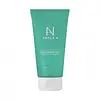What's inside
What's inside
 Key Ingredients
Key Ingredients

 Benefits
Benefits

 Concerns
Concerns

 Ingredients Side-by-side
Ingredients Side-by-side

Water
Skin ConditioningButylene Glycol
HumectantDipropylene Glycol
HumectantGlycerin
HumectantOlea Europaea Fruit Oil
MaskingPalm Oil Polyglyceryl-6 Esters
EmollientPolyglyceryl-4 Caprate
EmulsifyingPhaseolus Radiatus Seed Extract
Skin ConditioningArginine
MaskingCentella Asiatica Extract
CleansingCentella Asiatica Callus Conditioned Media
Skin ConditioningPhyllostachys Nigra Juice
EmollientMonascus Extract
Skin ConditioningRumex Crispus Root Extract
Skin ConditioningBetula Alba Juice
AstringentMelaleuca Alternifolia Leaf Extract
PerfumingMentha Piperita Leaf Extract
Skin ConditioningHouttuynia Cordata Extract
Skin ConditioningCamellia Sinensis Leaf Extract
AntimicrobialMorinda Citrifolia Extract
AstringentPetroselinum Sativum Extract
Skin ConditioningPropanediol
SolventCarbomer
Emulsion StabilisingAcrylates/C10-30 Alkyl Acrylate Crosspolymer
Emulsion StabilisingCaprylyl Glycol
EmollientOctyldodeceth-16
EmulsifyingEucalyptus Globulus Leaf Oil
PerfumingArgania Spinosa Kernel Oil
EmollientSimmondsia Chinensis Seed Oil
EmollientCamellia Japonica Seed Oil
EmollientCamellia Sinensis Seed Oil
HumectantMacadamia Integrifolia Seed Oil
Skin Conditioning1,2-Hexanediol
Skin ConditioningCitric Acid
BufferingEthylhexylglycerin
Skin ConditioningDisodium EDTA
Water, Butylene Glycol, Dipropylene Glycol, Glycerin, Olea Europaea Fruit Oil, Palm Oil Polyglyceryl-6 Esters, Polyglyceryl-4 Caprate, Phaseolus Radiatus Seed Extract, Arginine, Centella Asiatica Extract, Centella Asiatica Callus Conditioned Media, Phyllostachys Nigra Juice, Monascus Extract, Rumex Crispus Root Extract, Betula Alba Juice, Melaleuca Alternifolia Leaf Extract, Mentha Piperita Leaf Extract, Houttuynia Cordata Extract, Camellia Sinensis Leaf Extract, Morinda Citrifolia Extract, Petroselinum Sativum Extract, Propanediol, Carbomer, Acrylates/C10-30 Alkyl Acrylate Crosspolymer, Caprylyl Glycol, Octyldodeceth-16, Eucalyptus Globulus Leaf Oil, Argania Spinosa Kernel Oil, Simmondsia Chinensis Seed Oil, Camellia Japonica Seed Oil, Camellia Sinensis Seed Oil, Macadamia Integrifolia Seed Oil, 1,2-Hexanediol, Citric Acid, Ethylhexylglycerin, Disodium EDTA
Water
Skin ConditioningSodium Cocoamphoacetate
CleansingPEG-40 Glyceryl Cocoate
EmulsifyingAcrylates/C10-30 Alkyl Acrylate Crosspolymer
Emulsion StabilisingGlycerin
HumectantPEG-200 Hydrogenated Glyceryl Palmate
CleansingHydrated Silica
AbrasiveSodium Coceth Sulfate
CleansingSalicylic Acid
MaskingPEG-7 Glyceryl Cocoate
EmulsifyingXanthan Gum
EmulsifyingSodium Hydroxide
BufferingGluconolactone
Skin ConditioningPPG-26-Buteth-26
Skin ConditioningChlorphenesin
AntimicrobialPEG-40 Hydrogenated Castor Oil
EmulsifyingSodium Lauroyl Oat Amino Acids
CleansingParfum
MaskingDisodium EDTA
Caprylyl Glycol
EmollientCopper PCA
HumectantZinc PCA
HumectantXylitylglucoside
HumectantAnhydroxylitol
HumectantXylitol
HumectantButyl Avocadate
Skin ConditioningDipropylene Glycol
HumectantCI 74260
Cosmetic ColorantBoswellia Serrata Extract
Skin ConditioningTocopherol
AntioxidantWater, Sodium Cocoamphoacetate, PEG-40 Glyceryl Cocoate, Acrylates/C10-30 Alkyl Acrylate Crosspolymer, Glycerin, PEG-200 Hydrogenated Glyceryl Palmate, Hydrated Silica, Sodium Coceth Sulfate, Salicylic Acid, PEG-7 Glyceryl Cocoate, Xanthan Gum, Sodium Hydroxide, Gluconolactone, PPG-26-Buteth-26, Chlorphenesin, PEG-40 Hydrogenated Castor Oil, Sodium Lauroyl Oat Amino Acids, Parfum, Disodium EDTA, Caprylyl Glycol, Copper PCA, Zinc PCA, Xylitylglucoside, Anhydroxylitol, Xylitol, Butyl Avocadate, Dipropylene Glycol, CI 74260, Boswellia Serrata Extract, Tocopherol
 Reviews
Reviews

Ingredients Explained
These ingredients are found in both products.
Ingredients higher up in an ingredient list are typically present in a larger amount.
Acrylates/C10-30 Alkyl Acrylate Crosspolymer is a synthetic polymer. It is used to thicken and improve the texture of products. Due to its properties, it can prevent water and oil ingredients from separating.
Caprylyl Glycol is a humectant and emollient, meaning it attracts and preserves moisture.
It is a common ingredient in many products, especially those designed to hydrate skin. The primary benefits are retaining moisture, skin softening, and promoting a healthy skin barrier.
Though Caprylyl Glycol is an alcohol derived from fatty acids, it is not the kind that can dry out skin.
This ingredient is also used as a preservative to extend the life of products. It has slight antimicrobial properties.
Learn more about Caprylyl GlycolDipropylene Glycol is a synthetically created humectant, stabilizer, and solvent.
This ingredient helps:
Dipropylene glycol is technically an alcohol, but it belongs to the glycol family (often considered part of the ‘good’ alcohols). This means it is hydrating and gentle on skin unlike drying solvent alcohols like denatured alcohol.
As a masking agent, Dipropylene Glycol can be used to cover the smell of other ingredients. However, it does not have a scent.
Studies show Dipropylene Glycol is considered safe to use in skincare.
Learn more about Dipropylene GlycolDisodium EDTA plays a role in making products more stable by aiding other preservatives.
It is a chelating agent, meaning it neutralizes metal ions that may be found in a product.
Disodium EDTA is a salt of edetic acid and is found to be safe in cosmetic ingredients.
Learn more about Disodium EDTAGlycerin is already naturally found in your skin. It helps moisturize and protect your skin.
A study from 2016 found glycerin to be more effective as a humectant than AHAs and hyaluronic acid.
As a humectant, it helps the skin stay hydrated by pulling moisture to your skin. The low molecular weight of glycerin allows it to pull moisture into the deeper layers of your skin.
Hydrated skin improves your skin barrier; Your skin barrier helps protect against irritants and bacteria.
Glycerin has also been found to have antimicrobial and antiviral properties. Due to these properties, glycerin is often used in wound and burn treatments.
In cosmetics, glycerin is usually derived from plants such as soybean or palm. However, it can also be sourced from animals, such as tallow or animal fat.
This ingredient is organic, colorless, odorless, and non-toxic.
Glycerin is the name for this ingredient in American English. British English uses Glycerol/Glycerine.
Learn more about GlycerinWater. It's the most common cosmetic ingredient of all. You'll usually see it at the top of ingredient lists, meaning that it makes up the largest part of the product.
So why is it so popular? Water most often acts as a solvent - this means that it helps dissolve other ingredients into the formulation.
You'll also recognize water as that liquid we all need to stay alive. If you see this, drink a glass of water. Stay hydrated!
Learn more about Water